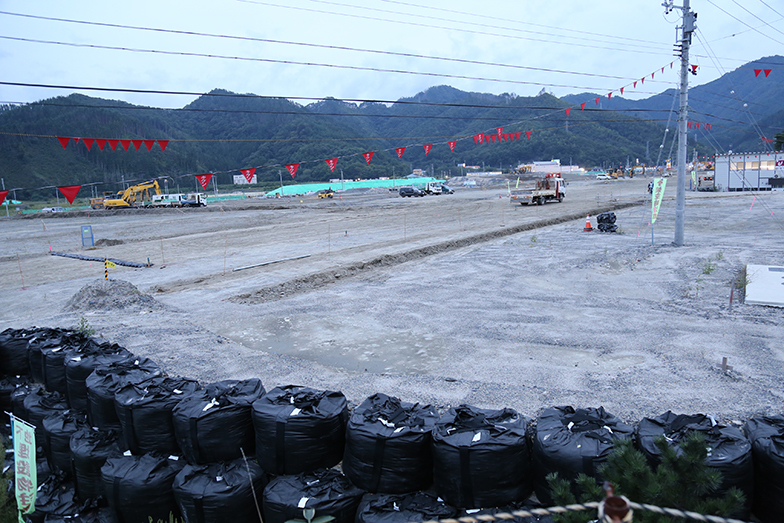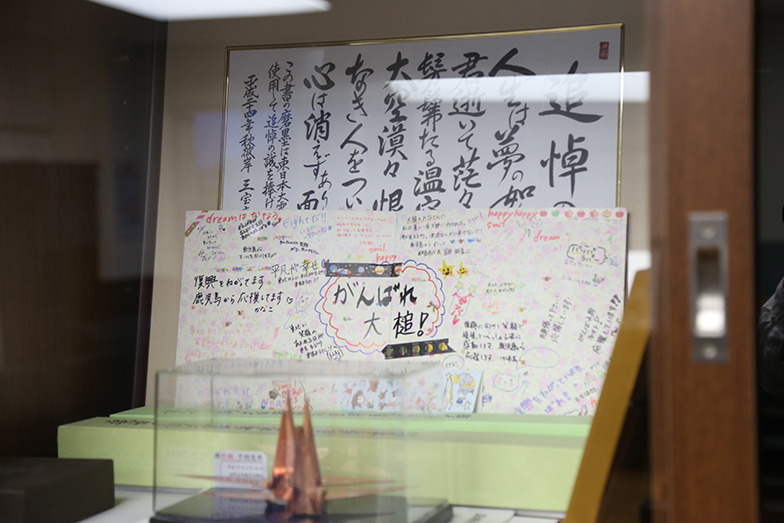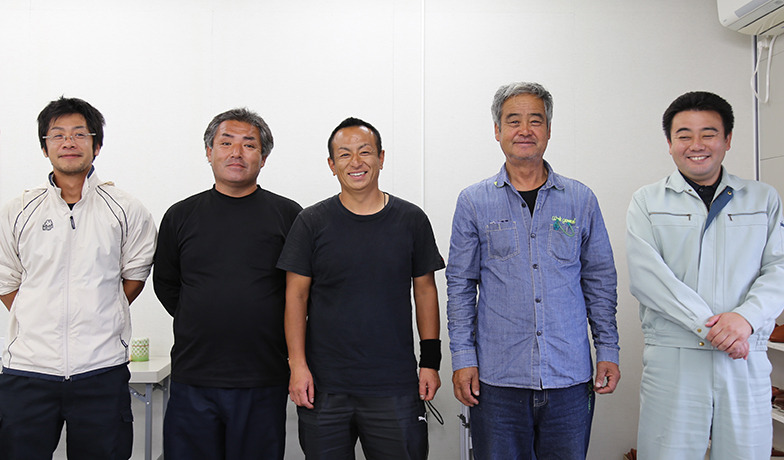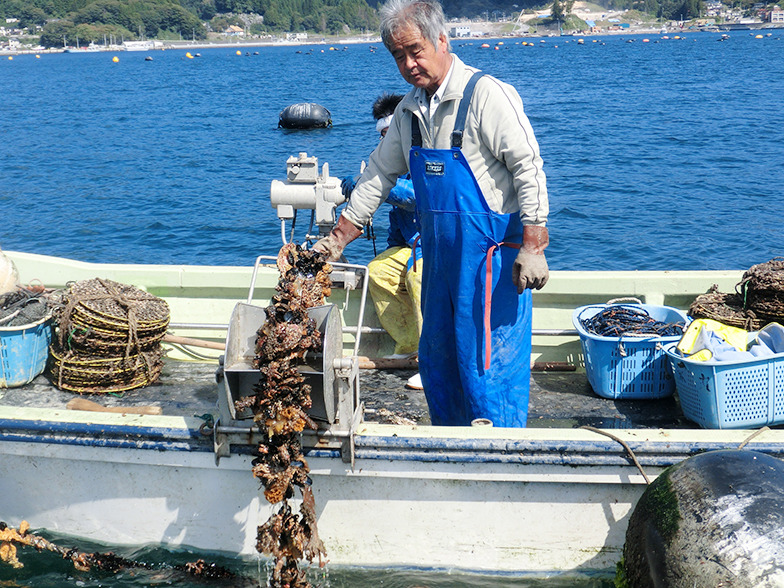Four and a half years have passed since the Great East Japan Earthquake, yet the reality in Tohoku is that recovery remains distant. Immediately after the disaster, Dentsu Inc. established the cross-organizational team "Tohoku Recovery Support Network." Working collaboratively with local residents and media, they have been active in aiming to contribute to Tohoku's recovery.
In this series, members of the network report on local voices from regions with which they have deep connections.
The first installment focuses on Ōtsuchi Town in Iwate Prefecture. This town, one of the areas severely damaged by the disaster, holds a special connection with Dentsu Inc., which has continuously assisted with joint memorial services for four years. Yuki Saotome of Dentsu Inc.'s MC Planning Bureau interviewed Mr. Kozo Hirano, who became the new mayor in September. Yuki Saotome of Dentsu Inc.'s Media Services / Newspaper Division interviewed Mr. Fumio Saito, Chairman of the Otsuchi Bay Scallop Farming Cooperative.

The former downtown area of Ōtsuchi Town is still in the land development phase.
One in four residents still lives in temporary housing. We want to listen to the unheard voices and rebuild the community.
In Ōtsuchi Town, the tsunami claimed the lives of 1,285 people, approximately 10% of the population. Furthermore, after the disaster, the younger generation left the town seeking work, leading to a continuous population decline and making aging a significant challenge.
Entering the town, dump trucks carrying fill dirt for the embankment construction race through the former downtown area, kicking up dust clouds. The town's shape remains unrecognizable. Opinions are divided among residents regarding the former town hall building, which bears witness to the tsunami's devastation, over whether it should be preserved as a "disaster remnant" or demolished.
Amid the loss of nearly half of the town's leadership, including the mayor, Mr. Hirano served as the unusual acting mayor for about two months starting in June 2011, holding the position of a general staff member (General Affairs Section Chief). From November 2011 until March of this year, he dedicated himself to town administration as the General Affairs Director and General Affairs Section Chief.
In this summer's Otsuchi mayoral election, he campaigned on revising the reconstruction plan through concentration and selection, based on the town's history, and won the election with the support of the townspeople.

Mayor Hirano discusses the current situation in Ōtsuchi Town. A large fishing flag, symbolizing encouragement, is displayed in the mayor's office.
Saotome: Could you once again explain the current situation in Ōtsuchi Town?
Hirano: While things have calmed down considerably, the harsh reality remains that one in four residents still lives in temporary housing.
Immediately after the disaster, we were so focused on wanting to live on higher ground that we didn't consider how long it would take to build up the land and install infrastructure on top. We want to shorten the delays in the physical construction work as much as possible. The longer people have to wait, the more some of them become discouraged. We especially want to provide strong emotional support for our elderly residents.
Saotome: You mentioned emotional support. What does that entail specifically?
Hirano: We see people in temporary housing feeling increasingly isolated as their neighbors move away, or becoming lonely after relocating to public disaster housing. Many end up living in areas different from their original neighborhoods, leading to a sense of loneliness as the communities they built up are fragmented. Building new communities is becoming crucial.
Saotome: So, precisely at this moment, community regeneration is crucial.
Hirano: We absolutely must create more and more opportunities for local residents to interact with each other. We're prioritizing projects and carefully assessing what's truly necessary. However, there are limits to changing the physical reconstruction that's already underway, so we're focusing our efforts on properly establishing the soft infrastructure.
It's also vital to carefully and thoroughly explain why construction is delayed, even when it's difficult to discuss.
Saotome: Valuing communication with residents – this is something you've emphasized since before becoming mayor, Mr. Hirano.
Hirano: I want to step outside the town hall, meet face-to-face, and listen to minority opinions. Rather than just amplifying loud voices or consolidating everyone's opinions, I aim to create an open town where the wisdom hidden in the unheard voices can become the collective wisdom of all.
Saotome: What about industrial promotion?
Hirano: While the number of people employed in fisheries is 3.8% of the town's population, and its share of the gross regional product is only a few percent, primary industries, especially fisheries, are a pillar of our community spirit. Indeed, a revitalized coastline strengthens us all. Coastal areas everywhere produce similar goods, making sixth-sector development (*) challenging, but I strongly believe we should cultivate a "Otsuchi Brand" we can be proud of. Wisdom matters more than money.
※Sixth-sector industrialization: An initiative promoted by the Ministry of Agriculture, Forestry and Fisheries to revitalize rural and fishing communities. It involves integrating primary industries (agriculture, forestry, fisheries) with related secondary and tertiary industries (processing, sales, etc.) to develop local business and create new business models.
Saotome: Isn't outside expertise also coming in?
Hirano: While the disaster was tragic, it's also true that it created unprecedented connections. Support from other municipalities and volunteers became a tremendous force. Even now, there are young people who love Ōtsuchi more than the locals and have stayed behind. We will also work to fully embrace the raw perspectives of such individuals.
Saotome: Finally, please share a message for Web Dentsu Inc. readers.
Hirano: The real test of our community's commitment begins now. We will build step by step to ensure those who remain in Ōtsuchi can live with pride and confidence.
There are many people outside the town who have some connection to Otsuchi—whether they are from here, have relatives or friends here, or simply share a bond. While it's often said that memories of the disaster fade, we want to keep sharing our recovery journey to maintain that connection with people outside. We will move forward steadfastly toward recovery, cherishing these connections both within and beyond our community.

Messages from Volunteers Displayed in the Mayor's Office
Revitalizing the shore with "Hyotan Island Active Scallops." Fishermen's first sales initiative.
Otsuchi Town was originally a thriving region for aquaculture, including wakame seaweed and scallops. The earthquake devastated fishing grounds and markets, leaving the original fishing cooperative insolvent and abandoning reconstruction. The newly formed "Otsuchi Bay Scallop Aquaculture Association" is working to build "visible relationships" directly with consumers and restaurant operators, without relying on the fishing cooperative that previously handled their product sales.

Members of the Otsuchi Bay Scallop Cultivation Association. We spoke with Chairman Fumio Saito (second from right).
Morio: I understand the scallop farming industry suffered devastating damage from the earthquake.
Saito: Before the disaster, about 45 people were involved. All the rafts used for farming were washed away, and initially, we were told restarting would be impossible. Somehow, we managed to restart with 8 people three months later in June. Currently, 10 people are active.
Morio: How does production compare to before the disaster?
Saito: The total volume has decreased, but individual production has increased about 2.5 times. Actually, the area expanded, so water circulation improved.
However, sales revenue is low. Even with a catch of about 15 tons per person, profits are zero after deducting expenses. Our seed-rearing facilities aren't fully equipped, so we buy the shortfall from Hokkaido. This year, the unit price has risen, further pushing up costs.
Until now, sales were handled by the fishing cooperative, but fishermen in their 30s and 40s have taken the lead in developing their own sales channels.
Morio: Are you handling sales too?
Saito: We're confident in our ability to produce high-quality products as fishermen. But we'd never done any sales activities before, so it was one challenge after another. To start, we began participating in events across Japan, starting in the Kanto region in 2013, to introduce our "Hyotan Island Live Scallops" harvested in Otsuchi Bay.

Mr. Saito hauling up scallops. Four years have passed since restarting aquaculture from scratch, but many challenges remain before stable supply can be achieved.
Morio: What are the characteristics of Otsuchi Bay scallops?
Saito: Otsuchi Bay is located in the heart of the Sanriku Coast, where the Oyashio and Kuroshio currents collide, creating an area rich in high-quality plankton. Three rivers flow into the bay, ensuring a constant circulation of fresh seawater. The "Hyotan Island Live Scallops" cultivated here are characterized by their thick adductor muscles, a uniquely strong sweetness, and a firm, fibrous texture.
Their commitment to quality has been recognized, earning high praise from renowned French chefs and Tokyo sushi restaurants.
Morio: So you've started direct sales to individuals as well.
Saito: There's an endless list of tasks—from landing the catch to processing, packing, shipping, and sales activities. Even with an average of three hours of sleep, I can barely keep up. Right now, we're focusing on keeping prices low to get the word out and increase volume. We even offer experience tours.

During the growth process, scallops are sorted by size and cultivated using a method called "ear hanging," where holes are drilled into the ear-shaped part of each shell and the scallops are suspended.
At shipping time, mussels attached to the scallops are carefully scraped off with a hatchet. This is all done by hand.
Morio: The mayor also spoke about the necessity of the Ōtsuchi brand.
Saitō: We named them "Hyōtan Island Live Scallops" because Hōraijima Island in Ōtsuchi Bay was the model for Hyōtan Island featured on an NHK children's program.
We want people to taste the care we put into raising them, and little by little, fans are growing nationwide.
We want to ensure a stable supply of "Hyotan Island Fresh Scallops," a symbol of recovery, as soon as possible. This will allow us to train successors who can engage in fishing with peace of mind.

Hyotan Island floating in Otsuchi Bay
For details on "Hiyotan Island Live Scallops," visit http://ootsuchi-hotate.jimdo.com/
















